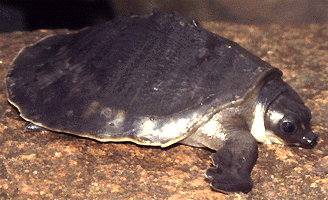

|
Keys to the Turtles of Australia
|

|
Introduction
Australia has a unique turtle fauna renowned for its predominance of Pleurodire's or side necked turtles. Poor taxonomy has hampered the study of this fauna, which is by and large caused by this countries under appreciation of the field of taxonomy. This has left us with no ability to appreciate the diversity of freshwater and marine forms that occur here. The taxonomy for the marine forms is relatively stable, but studies of the freshwater turtles in Australia have been greatly hindered by lack of formal descriptions for many distinct forms of long standing, and a lack of keys for the identification of species. These problems have encouraged me to publish this technical note.
The highest diversity of turtles in Australia occurs in the Daly River which is home to eight of the eleven species that occur in the Northern Territory. They span two families representing four genera. Three of those species are in the genus Emydura and the Daly
is also the only place where two forms from the genus Macrochelodina occur together.
Keys to the Families, Genera and Species of Australian turtles are presented, the product of nearly ten years of morphological analysis by the author. I had planed to publish these keys as a part of a more substantial work, but believe web circulation would be appreciated by those confused with the current literature and will allow my keys to undergo more rigorous testing. The most difficult group was the Emydura, where I was forced to work backwards from animals identified by electrophoresis (Georges and Adams, 1992; 1996). Important changes include the recognition of widespread populations of an Australian variant
of Emydura subglobosa, formerly thought to be restricted in Australia to the tip of Cape York; delimitation of the Northern Redface turtle to rivers to west of and including the Daly River; and identification of a third form of Emydura present in the Daly and to the east and west. When keying out the Emydura it is advisable to have a series of each until you become familiar with them as Emydura subglobosa and Emydura tanybaraga are very difficult to distinguish. For the raw species list I use Georges and Thomson (2001) as the species list in here is the only one available that has hard scientific evidence to support it. Keys for the marine turtles have been gleaned from the literature, mostly Cogger (1992) and Legler (1993). Keys for the Chelids are from my own research, and I am keen to receive feedback on their effectiveness.
Using the Keys
I am placing the keys on the web as I think this is probably the most user friendly environment for keys to species. Basically because the way web pages are stored and are linked to each other is identical to the way keys work. Click on the keys icon above to start, this will take you to the keys to families page. Key your species to family, or if you know what family it is find the link to that family and continue from there. When using keys remember that they are designed for the typical representative of the species. Not all specimens of a population key out well, this does not make it new just a variant. These occur in all species, including humans, and it is not possible for any key to find every animal. However, you should be able to get to genus and have an idea what species it is, common sense will usually help the rest of the way. I have deliberately kept graphics out of the keys pages, though the final species pages include pictures. This is to decrease download times. So the pretty pictures are at the end not in the middle. The only graphics in the keys themselves are explanatory drawings. This should allow most users to speed through the keys when they are reasonably sure of what they have and want to start at the species level.
Acknowledgements
I must take the opportunity to thank those who have assisted me in my endeavours to delineate all the Australian freshwater turtles. All the collection managers at various museums who have given me access to their collections, Patrick Couper (Queensland Museum), Ross Sadlier (Australian Museum), Laurie Smith (Western Australian Museum) and Paul Horner (Museum and Art Galleries of the Northern Territory), John Legler (Museum of Natural History, University of Utah), Jose Rosado (Museum of Comparative Zoology), David Auth (Florida State Museum), Linda Ford (American Museum of Natural History) and Colin MacCarthy (Natural History Museum, London). I must also thank John Cann, Peter Pritchard, Bill McCord and Anders Rhodin for all their advice over the years and the loans of turtles from their personal collections, Rod Kennett and Peter Whitehead for their assistance with obtaining turtles from the Northern Territory, and Ross Jeffree for supplying me with specimens from a previous study. Lastly, I must thank Arthur Georges who has encouraged me for a number of years to continue with my studies of the morphology of turtles.
To the Keys --> Click to Begin